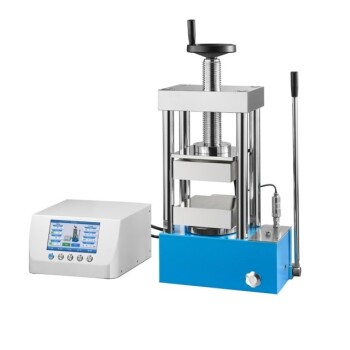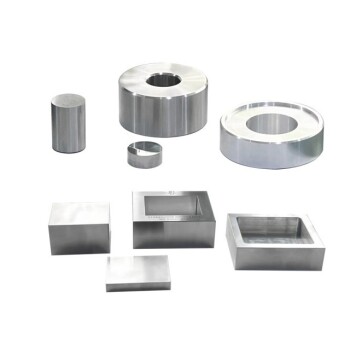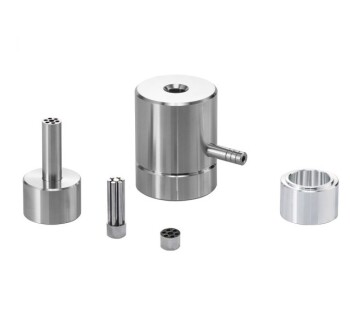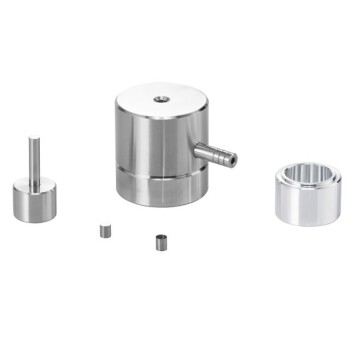At its core, the versatility of a heated lab press is directly determined by its platen configuration. The platens' size, material, and thickness dictate not only the physical dimensions of the samples you can process but also the thermal and chemical conditions you can apply, fundamentally expanding the press's range of applications from simple molding to advanced materials science.
The choice of platen configuration is not merely about accommodating a sample. It is about precisely matching the press's thermal and mechanical capabilities to the specific requirements of your material and experimental goal.
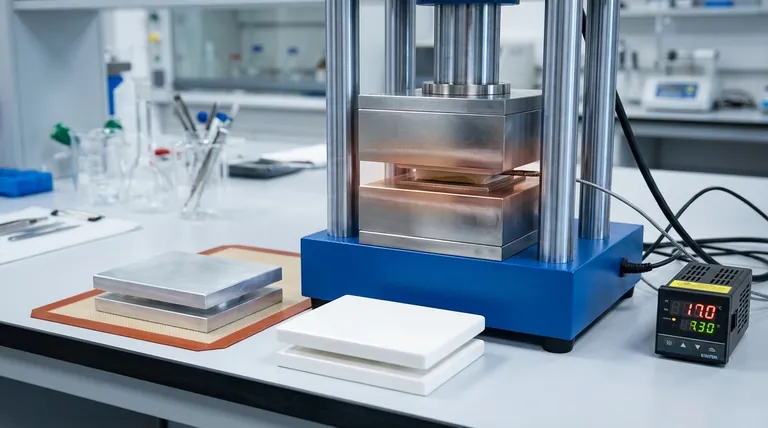
The Three Pillars of Platen Versatility
To understand how a press can be adapted for different tasks, we must analyze the three fundamental characteristics of its platens.
Platen Size: Scaling Your Throughput
The most obvious feature, platen size, directly impacts both sample dimensions and operational efficiency.
Larger platens naturally accommodate bigger samples. More importantly, they enable multi-sample processing, allowing you to press several smaller samples simultaneously, which is critical for quality control or small-scale production environments.
Smaller platens are suitable for limited lab space or highly focused experiments on small material quantities. They can also offer faster heat-up times compared to a massive platen of the same thickness.
Platen Material: Tailoring for Thermal and Chemical Needs
The material composition of the platen is crucial for compatibility with your experiment. Interchangeable platens are the hallmark of a truly versatile press.
- Chrome-Plated or Stainless Steel: These are the workhorses, offering excellent durability, good heat transfer, and general chemical resistance. They are ideal for a wide range of standard applications.
- Aluminum: Chosen for its superior thermal conductivity, aluminum allows for rapid heating and cooling cycles. This is valuable when cycle time is a critical process parameter.
- Ceramic: When exceptional temperature stability or electrical insulation is required, ceramic platens are the ideal choice. They provide consistent heat but may have slower response times.
Platen Thickness: Ensuring Temperature Uniformity
Platen thickness is a critical factor for process control and repeatability.
A thicker platen acts as a larger thermal mass. This helps to absorb and distribute heat more evenly, minimizing temperature fluctuations across the surface of the sample.
This temperature uniformity is non-negotiable for applications where precise thermal curing or molding is required. Thinner platens may be less expensive and heat faster, but they risk creating hot spots that can compromise the integrity of your results.
Understanding the Trade-offs
No single configuration is perfect for every scenario. Achieving maximum versatility means understanding the inherent compromises.
Size vs. Uniformity
While a large platen offers flexibility, ensuring perfect temperature uniformity across its entire surface is more challenging and often requires a more advanced and expensive heating system.
Material vs. Application
Aluminum platens provide rapid heating but may not have the surface hardness or chemical resistance of stainless steel for abrasive or corrosive materials. Ceramic is stable at high temperatures but is more brittle and may not be suitable for high-pressure impact applications.
Thickness vs. Responsiveness
Thicker platens deliver superior temperature stability but will invariably take longer to reach the setpoint temperature and longer to cool down. This increases the overall cycle time for each experiment.
Making the Right Choice for Your Application
Selecting the right platen configuration requires a clear understanding of your primary objective.
- If your primary focus is high-throughput QC or production: Prioritize larger platens that support multi-sample processing to maximize efficiency.
- If your primary focus is materials research and development (R&D): Invest in a press with an interchangeable platen system and acquire sets made from different materials (e.g., steel, aluminum).
- If your primary focus is achieving precise, repeatable results: Specify thicker platens to guarantee the highest degree of temperature uniformity across your sample.
By strategically matching the platen configuration to your goal, you transform the lab press from a brute-force tool into a precision instrument.
Summary Table:
| Platen Feature | Impact on Versatility | Best For |
|---|---|---|
| Size | Enables multi-sample processing and accommodates various sample dimensions | High-throughput QC or production |
| Material | Tailors thermal and chemical compatibility (e.g., steel, aluminum, ceramic) | Materials R&D and specific application needs |
| Thickness | Ensures temperature uniformity and process repeatability | Precise, repeatable results in experiments |
Ready to enhance your lab's capabilities with the right platen configuration? KINTEK specializes in lab press machines, including automatic lab presses, isostatic presses, and heated lab presses, designed to meet your laboratory needs with superior efficiency and precision. Contact us today to discuss how our solutions can optimize your processes and deliver reliable results!
Visual Guide

Related Products
- 24T 30T 60T Heated Hydraulic Lab Press Machine with Hot Plates for Laboratory
- Manual Heated Hydraulic Lab Press with Integrated Hot Plates Hydraulic Press Machine
- Automatic High Temperature Heated Hydraulic Press Machine with Heated Plates for Lab
- Lab Heat Press Special Mold
- Heated Hydraulic Press Machine with Heated Plates for Vacuum Box Laboratory Hot Press
People Also Ask
- What is the primary function of a hydraulic heat press? Achieve Precise Bonding and Shaping with Controlled Force and Heat
- What are the advantages of using a hydraulic heat press? Achieve Precision and Efficiency in Material Processing
- How is a hydraulic heat press used in laboratory sample preparation? Create Uniform Samples for Accurate Analysis
- What is the role of a hydraulic press with heating capabilities in constructing the interface for Li/LLZO/Li symmetric cells? Enable Seamless Solid-State Battery Assembly
- What is a hydraulic hot press machine and how does it differ? Unlock Precision in Material Processing
